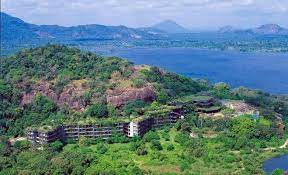Sri Lanka travel notes
Have you ever been to a perfect spot and wished “there should be an amazing hotel right there, except I want the hotel without any accompanying crowding or corruptions of tourism?”
If that is your desire, Sri Lanka is the country for you. (Who cares if that is an apparent violation of the laws of economics and location theory?) If you have visited Sri Lanka, likely you will know what I mean — it is simply so nice. So much the right blend of exotic and comfortable. It feels so unspoilt, so fresh, and so natural. So easy on the visitor, as if it were a well-run state of India with a big dose of Buddhism and a vaguely Caribbean vibe, and without the extreme population density.
Here was my Kandalama hotel, let the link rotate through all the images.

Here is my current hotel, only about 30 or 40 feet away from one of the world’s major Buddhist temple complexes, medieval and mostly dating from the 12th century. None of it is close to expensive, no matter how high the quality.
Galle, on the southern coast, is a lovely colonial city, largely intact, with notable Dutch, Portuguese, and British buildings, as well as mosques. It is ringed by an old fort, and has numerous good views of the ocean. Everything is walkable. Russians are the single largest tourist group there (no visa required), and yet the town does not feel overwhelmed, even on the cusp of August. Try Galle Fort Hotel, which is also a UNESCO heritage site.
There is an aesthetic look to so many things. If a farmer builds a tree house so he can monitor his crops at night without being stomped by elephants, the tree house will be pretty nice, even though the farmer is poor.
So much of Sri Lanka feels like the 1980s, in a way that is good for you but not good for them. On the plus side, education, literacy (92%), and social indicators are high. Life expectancy is higher than in the United States. You can drive around deep into the rural areas, and you just won’t see extreme poverty. Nor are the drivers crazy, so the travel isn’t stressful. The country never seems internet-obsessed.
The total fertility rate is currently about 2.0, a blessing in the short run but likely a disaster over time. At about 4k per capita income (about 14k PPP), Sri Lanka cannot afford to grow old before it becomes wealthy. And I can assure you, it is not on the verge of becoming wealthy.
The important buildings — and there are many of them — are all of earlier vintages. The hotels of Geoffrey Bawa — in a style sometimes called “tropical modernism” — are of special interest. Simply tracking down all of the Bawa hotels would be a good way of organizing your trip. Sri Lanka is one of the few countries in the world where the very nice old architecture and the very nice newer architecture bear some aesthetic relation to each other.
Did I mention this?:
In 2022, with its GDP contracting by 7.8%, Sri Lanka was one of the worst performing economies in the world. Annual inflation was around 60%, and the currency depreciated by over 80%. These quantifiable measures of pain were exacerbated by severe shortages and uncertainty in accessing fuel, gas and medicines. Daily power cuts became normalized.
Living standards remain lower, yet visible signs of those earlier troubles are gone. The infrastructure now works once again, yet the country feels psychically scarred by the recent economic collapse.
One Sri Lankan MR reader, with whom I chatted, argued that the country has no person or not even a group “in charge” at the wheel. So small problems drift and sometimes turn into major crises. The country’s “immune system” simply is not functioning.
It is striking that none of the major parties have good ideas, as there is mainly corrupt oligarchy or Marxists. Liberalism is nowhere to be seen. Behind the scenes, Sri Lanka is a country that outside parties (most of all China and India, earlier the colonial powers) have cared about far too much. It never feels like there is a stable political equilibrium upon which to build, because the outsiders have so much power.
Internally, they still have not generated a true consensus on what the country is about, and if they are all willing to live in peace with each other. As one of my drivers put it succinctly: “I don’t like the other religions.”
With textiles and tea as the major exports, the country shows no signs of moving up the value chain. Nonetheless Sri Lanka remains richer per capita than India. And easier to handle, albeit far less dynamic. Someone could write a very Sri Lankan version of “the complacent class.”
How good is Buddhism for economic growth anyway?
I will do a separate post on food in Sri Lanka.